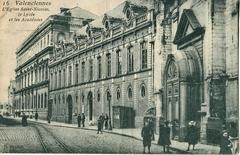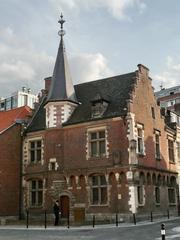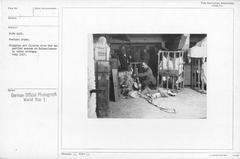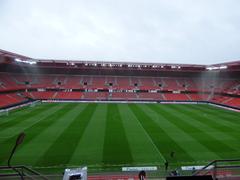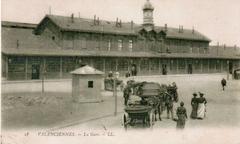
Stade Nungesser: Visiting Hours, Tickets, and Guide to Valenciennes’ Historical Site
Date: 03/07/2025
Introduction
Stade Nungesser, once the vibrant epicenter of football in Valenciennes, France, is a site rich in both sporting and cultural significance. Established in 1929 and named after Charles Nungesser—a World War I flying ace born in Valenciennes—the stadium symbolized local pride and unity, serving as the home ground of Valenciennes Football Club (VAFC) for over eight decades (pss-archi.eu; Wikipedia). Known for its electrifying atmosphere—earning the nickname “Enfer du Nord” or “Hell of the North”—Stade Nungesser was a landmark in both the city’s urban landscape and collective memory.
Despite its cherished status, the stadium’s aging facilities ultimately led to its closure in 2011 and demolition in 2012. The original site was transformed into the Centre Aquatique Nungesser, a modern aquatic and community complex that opened in 2020 (stadiumtraveller.com; tourismevalenciennes.fr). Today, visitors can explore the site’s legacy through the aquatic center, enjoy football at the nearby Stade du Hainaut, and discover Valenciennes’ broader cultural offerings.
This comprehensive guide provides in-depth information on Stade Nungesser’s history, cultural significance, practical visiting details, and tips for exploring the surrounding area. Whether you are a football fan, history enthusiast, or curious traveler, this article will enrich your understanding of one of northern France’s most iconic sporting landmarks (Football Tripper; Sortie-Visite).
Table of Contents
- Origins and Construction of Stade Nungesser
- The “Enfer du Nord” and Stadium Development
- Expansion and Modernization
- Valenciennes FC and Memorable Moments
- Closure, Demolition, and New Life of the Site
- Visiting Today: Centre Aquatique Nungesser
- Access, Transportation, and Nearby Attractions
- FAQs and Visitor Tips
- References and Useful Links
Origins and Construction
Stade Nungesser was constructed in 1929 as the primary football venue for Valenciennes—then known as Union Sportive Valenciennes-Anzin (USVA). Named after Charles Nungesser, the stadium quickly became a symbol of local pride. Its original design featured basic stands and open terraces, reflecting the utilitarian style of early 20th-century French stadiums and catering to the region’s growing football enthusiasm (pss-archi.eu).
The “Enfer du Nord” and Stadium Development
Nicknamed “Enfer du Nord” (“Hell of the North”), Stade Nungesser developed a reputation for its intense, intimidating atmosphere. The metallic stands magnified the crowd’s fervor, creating a formidable environment for visiting teams and cementing the stadium’s legendary status among fans (pss-archi.eu).
In the 1950s and 1990s, the stadium underwent significant renovations. A main stand, the “tribune d’honneur,” was added in 1955, boosting capacity and comfort. Later, a covered stand was constructed behind the east goal in 1992—though its roof was destroyed by a storm and only rebuilt years later (pss-archi.eu).
Expansion and Modernization
- 1955: Addition of the main stand increased the stadium’s capacity to 21,500, with 8,500 seated.
- 1992: Covered stand built (roof rebuilt in 2006 after storm damage), plus a temporary stand added (pss-archi.eu).
- 2000s: Facilities became outdated, leading to plans for a new stadium that would meet modern safety and comfort standards (stadiumtraveller.com).
Valenciennes FC and Memorable Moments
Stade Nungesser played a central role in the history of Valenciennes FC (VAFC), hosting unforgettable matches, cup ties, and promotion celebrations. The stadium’s close stands fostered a unique matchday atmosphere that fans still remember fondly. Noteworthy is the club’s Ligue 2 triumph in 2005/2006, which returned VAFC to Ligue 1 and reignited citywide football fervor (Football Tripper; Soccerwizdom).
Beyond football, Stade Nungesser also hosted athletics and community events, reinforcing its status as a multi-purpose civic space (Wikipedia).
Closure, Demolition, and New Life of the Site
Decline and Transition
By the early 2000s, Stade Nungesser’s infrastructure no longer met professional football standards. The need for modern amenities led to the construction of Stade du Hainaut, which opened in 2011 (stadiumtraveller.com). Stade Nungesser’s final match was played in May 2011, after which the stadium was demolished in 2012.
Transformation: Centre Aquatique Nungesser
The former stadium site was redeveloped as the Centre Aquatique Nungesser, inaugurated in 2020. This aquatic complex now serves as a community hub, with swimming pools, wellness areas, and family facilities (tourismevalenciennes.fr).
Commemoration
Although the stadium is gone, its memory endures through local monuments, street names, and the enduring football culture of Valenciennes. A monument to Charles Nungesser remains near the aquatic center, preserving the site’s historical identity (Wikipedia).
Visiting Today: Centre Aquatique Nungesser
Location and Accessibility
- Address: Avenue de Reims, Nungesser district, Valenciennes (Wikipedia).
- Public Transport: Take tramway line A to Nungesser station (direct from city center and train station).
- Parking: Centre Aquatique Nungesser provides modern parking for visitors.
Visiting Hours and Tickets
- Stade Nungesser: No longer stands—no ticketing or set visiting hours.
- Centre Aquatique Nungesser: Open year-round, with extended hours on weekends and holidays. Check the official website for current schedules and prices.
- Stade du Hainaut: Tickets for matches and tours are available via the club’s official website (va-fc.com).
On-Site Experience
- Explore the aquatic center’s modern facilities.
- View commemorative monuments and plaques.
- Walk the grounds and imagine the vibrant matchdays of the past.
Access, Transportation, and Nearby Attractions
Getting There
- By Train: Valenciennes Gare is 2 km from the site; tram and bus connections available.
- By Tram: Line A, Nungesser stop.
- By Car: Parking on-site at the aquatic center.
Nearby Attractions
- Stade du Hainaut: Modern stadium hosting VAFC matches and events (Stadium Guide).
- Musée des Beaux-Arts: Major art museum with works by Watteau and other masters.
- Place d’Armes: Historic city square with shops and restaurants.
- Jardin de la Rhônelle: Landscaped city park (Sortie-Visite).
Dining and Accommodation
- Local specialties: Lucullus, goyère au maroilles.
- Accommodation: Numerous hotels and guesthouses nearby (Booking.com).
FAQs and Visitor Tips
Q: Can I visit Stade Nungesser today?
A: The stadium was demolished in 2012, but you can visit the site—now the Centre Aquatique Nungesser.
Q: Are there tickets to visit Stade Nungesser?
A: No tickets are required for the site. For football matches, purchase tickets for Stade du Hainaut.
Q: What are the visiting hours for the Centre Aquatique Nungesser?
A: Open year-round; confirm current hours on the official website.
Q: Is the site accessible to visitors with reduced mobility?
A: Yes, both the aquatic center and the tram system are accessible.
Q: Are tours available?
A: While there are no tours of the former stadium, guided tours of Stade du Hainaut often include references to Stade Nungesser (Sortie-Visite).
Q: What else should I see nearby?
A: Visit the historic city center, Musée des Beaux-Arts, Place d’Armes, and local parks.
References and Useful Links
- pss-archi.eu
- Wikipedia
- stadiumtraveller.com
- tourismevalenciennes.fr
- Football Tripper
- Sortie-Visite
- Soccerwizdom
- Stadium Guide
- Booking.com
- The Crazy Tourist
Summary
Stade Nungesser’s story is deeply woven into Valenciennes’ identity, from its early 20th-century origins to its transformation into a modern community hub. While the stadium itself is gone, its legacy endures through the Centre Aquatique Nungesser, the commemorative monuments, and the ongoing football culture at Stade du Hainaut. With excellent public transport, accessible facilities, and a wealth of nearby cultural attractions, the Nungesser site remains a meaningful destination for those seeking to explore Valenciennes’ rich sporting and historical heritage (Tourisme Valenciennes; Stadium Guide).
Enhance your visit by downloading the Audiala app for personalized guides, insider tips, and up-to-date information on Valenciennes’ attractions.
Recommended visuals:
- Photo of the Centre Aquatique Nungesser exterior (“Centre Aquatique Nungesser aquatic complex”)
- Image of the Charles Nungesser monument (“Charles Nungesser monument at Stade Nungesser site”)
- Map of Valenciennes showing the Nungesser district and attractions (“Map of Valenciennes historical sites including Stade Nungesser”)





